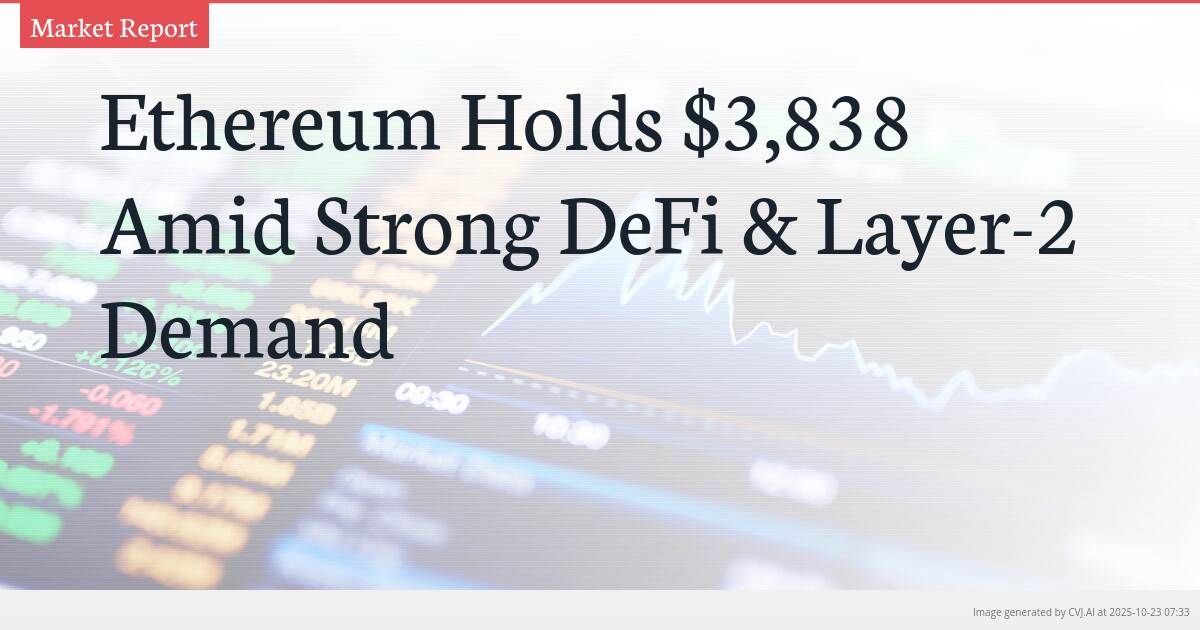This summary text is fully AI-generated and may therefore contain errors or be incomplete.
Introduction
Ethereum demonstrates resilience at $3,838.70 despite mixed momentum across broader cryptocurrency markets. The asset maintains strong investor confidence due to its central role in decentralized finance and expanding Layer-2 ecosystem. Institutional inflows and robust on-chain activity continue to position ETH among 2025’s top-performing altcoins.
Key Points
- ETH shows technical strength trading above $3,700 support with potential 20% upside to $4,000-$4,900 if resistance breaks
- Layer-2 scaling solutions are processing record transaction volumes, driving long-term network demand and reducing fee pressure
- High staking participation continues to lock significant ETH supply, creating scarcity while network upgrades focus on improving validator efficiency and scalability
Technical Analysis Reveals Strategic Entry Points
Ethereum’s current trading position at $3,838.70 presents a compelling technical picture for traders and investors. The asset has established strong support near $3,700, with major resistance forming in the $3,950–$4,000 range. This technical setup suggests potential for significant movement in either direction, making risk management crucial for market participants. The Relative Strength Index (RSI) reading of 52 indicates balanced buying and selling pressure, providing a neutral foundation for potential upward momentum.
Despite reaching a new all-time high of $4,956, Ethereum has shown some concerning patterns with consecutive lower highs and lower lows since that peak. This technical behavior warrants careful monitoring, though the overall uptrend remains intact. Trading above the 50-day Exponential Moving Average (EMA) confirms steady mid-term momentum, supporting the bullish case for ETH. Analysts identify strategic entry points around the $3,400 support level, which could offer swing trade opportunities with approximately 20% upside potential back to $4,000 or even a retest of the $4,900 all-time high.
Risk management remains paramount in current market conditions. The recommended stop-loss level at $2,950 provides a clear risk parameter for traders, while the $463.32 billion market cap and $42.86 billion 24-hour trading volume demonstrate substantial market depth and liquidity. With 120.70 million ETH in circulating supply and no fixed maximum cap under Ethereum’s dynamic issuance model, the network maintains flexibility in its monetary policy while continuing to attract institutional and retail interest.
Layer-2 Ecosystem and Staking Drive Fundamental Strength
Ethereum’s fundamental strength extends far beyond price action, anchored by accelerating Layer-2 scaling adoption and robust staking participation. The Layer-2 ecosystem, including zk-rollups and Optimism chains, is processing record transaction volumes, significantly reducing network congestion and fee pressure while maintaining Ethereum’s security guarantees. This scaling solution adoption directly addresses one of the network’s historical challenges while creating sustainable long-term demand for block space and ETH as the native currency.
High staking participation continues to lock substantial portions of ETH supply, effectively reducing liquid availability and creating natural scarcity dynamics. This staking mechanism not only secures the network through Ethereum’s proof-of-stake consensus but also removes circulating supply from the market, potentially creating upward price pressure as demand increases. The combination of reduced liquid supply and growing network utility creates a powerful fundamental backdrop supporting Ethereum’s valuation.
Ongoing network upgrades focusing on scalability and validator efficiency represent another critical pillar of Ethereum’s long-term value proposition. The next planned upgrade continues Ethereum’s tradition of continuous improvement, addressing key bottlenecks while enhancing network performance. These technical enhancements, combined with Ethereum’s established position in decentralized finance (DeFi) and NFTs, reinforce its status as a foundational blockchain platform with real-world utility and adoption.
Market Position and Institutional Validation
Ethereum maintains its position as a leading altcoin for long-term growth, supported by both developer innovation and increasing institutional acceptance. The network’s central role in decentralized finance continues to expand, with platforms like Uniswap demonstrating the practical utility and economic activity generated within the Ethereum ecosystem. This DeFi dominance, combined with Ethereum’s established NFT infrastructure, creates multiple revenue streams and use cases that extend beyond simple speculation.
Institutional validation has become increasingly evident through developments like VanEck’s zero-fee spot Ethereum ETF announcement until 2025. Such products provide traditional investors with regulated exposure to ETH while acknowledging its status as a legitimate asset class. The combination of institutional products, developer activity, and real-world applications positions Ethereum uniquely within the cryptocurrency landscape, bridging the gap between decentralized innovation and mainstream financial infrastructure.
Looking forward, Ethereum’s path appears promising though not without potential challenges. A break above the $4,000 resistance level could trigger a rally toward $4,200–$4,300 in the coming weeks, while a dip below support might lead to a short-term correction toward $3,500. However, the underlying fundamentals—including Layer-2 adoption, staking participation, network upgrades, and institutional acceptance—suggest that Ethereum remains one of the most attractive long-term investments in the cryptocurrency market, capable of weathering short-term volatility while building toward sustained growth.
📎 Read the original article on coincodecap.com

